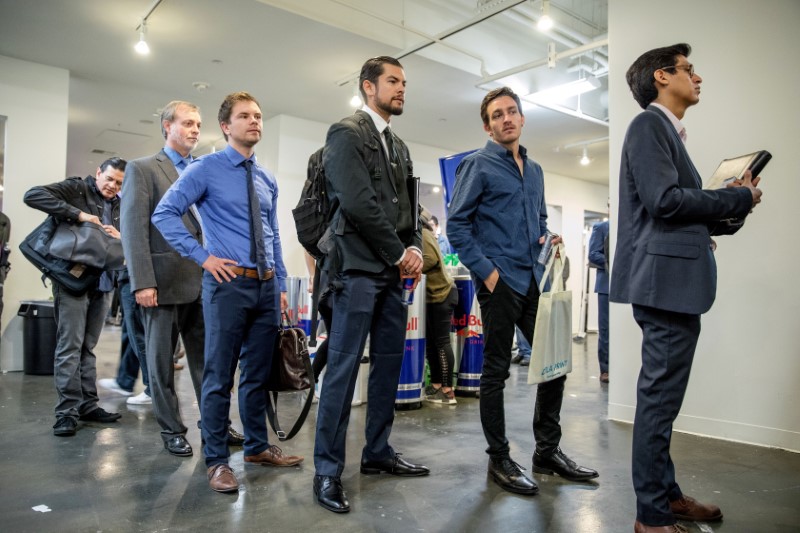By Lucia Mutikani
WASHINGTON (Reuters) - U.S. consumer prices recorded their largest increase in nearly 6-1/2 years in the year through June, while the monthly pace continued to suggest a steady buildup of inflation that could keep the Federal Reserve on a path of gradual interest rate increases.
Other data on Thursday showed first-time applications for unemployment benefits dropped to a two-month low last week as the labor market strengthened further. The tight jobs market is supporting inflation, and import tariffs, which are set to be broadened to include consumer goods, could fan price pressures.
"U.S. inflation continues to drift gradually higher in response to a nearly fully employed economy, with some nudging from tariffs," said Sal Guatieri, a senior economist at BMO Capital Markets in Toronto.
The Labor Department said its Consumer Price Index edged up 0.1 percent last month on moderate gains in gasoline prices and sharp declines in the cost of apparel and hotel accommodation. The CPI rose 0.2 percent in May.
In the 12 months through June, the CPI increased 2.9 percent, the biggest rise since February 2012, after advancing 2.8 percent in May.
With gasoline prices rising modestly and the cost of household utilities dropping in recent months, the increase in the annual inflation rate is expected to slow.
Excluding the volatile food and energy components, the CPI rose 0.2 percent, matching May's gain. That lifted the annual increase in the so-called core CPI to 2.3 percent, the largest rise since January 2017, from 2.2 percent in May.
Economists polled by Reuters had forecast both the CPI and core CPI rising 0.2 percent in June.
The Fed tracks a different inflation measure, which hit the U.S. central bank's 2 percent target in May for the first time in six years. Economists expect the personal consumption expenditures (PCE) price index, excluding food and energy, to slightly overshoot its target.
Fed officials have indicated they would not be too concerned with inflation overshooting its target. The Fed raised interest rates in June for a second time this year and has forecast two more rate hikes before the end of 2018.
"While we continue to expect the next hike in September, even the hawks may sound more comfortable with the current gradual tightening pace," said Michael Feroli, an economist at JPMorgan (NYSE:JPM) in New York.
The dollar was little changed against a basket of currencies while stocks on Wall Street were trading higher. Prices for U.S. Treasuries were mostly flat.
LOW LAY-OFFS
In another report on Thursday, the Labor Department said initial claims for state unemployment benefits dropped 18,000 to a seasonally adjusted 214,000 for the week ended July 7, the lowest level since early May.
That suggests robust labor market conditions prevailed in early July after the economy added 213,000 jobs in June. Steadily rising inflation, however, is eating into workers' modest wage gains. Inflation-adjusted average weekly earnings rose 0.1 percent in June following a similar gain in May.
While economists do not expect inflation to accelerate much from current levels, they cautioned that the Trump administration's protectionist trade measures could boost prices. Tariffs on lumber, aluminum and steel imports have left
manufacturers facing rising input costs.
So far, they have not passed on those higher costs to consumers. President Donald Trump imposed the tariffs to protect domestic industries from what he says is unfair competition from foreign manufacturers.
Last week, Trump slapped 25 percent tariffs on $34 billion of Chinese imports. On Tuesday, Trump threatened 10 percent tariffs on an additional $200 billion of Chinese goods.
"We do not anticipate much movement in the year-ago rate of core CPI over the next few months," said Sarah House, a senior economist at Wells Fargo (NYSE:WFC) Securities in Charlotte, North Carolina. "Broadening tariffs, including the possibility of consumer goods getting hit directly, create some upside risk to our inflation forecast in the second half of the year, however."
In June, gasoline prices rose 0.5 percent after increasing 1.7 percent in May. Food prices gained 0.2 percent, with food consumed at home rebounding 0.2 percent after falling 0.2 percent in May. Food prices were unchanged in May.
Owners' equivalent rent of primary residence, which is what a homeowner would pay to rent or receive from renting a home, rose 0.3 percent last month after increasing by the same margin in May. But the cost of hotel accommodations fell a record 4.1 percent.
Healthcare costs advanced 0.4 percent, with the price of hospital services surging 0.8 percent. Healthcare prices gained 0.2 percent in May, and consumers also paid more for prescription medication last month.
Prices for new motor vehicles rose for a second straight month. There were also increases in the cost of communication, motor vehicle insurance, education and alcoholic beverages.

But apparel prices fell 0.9 percent after being unchanged in May. The cost of airline tickets declined for a third straight month, while prices of household furnishings and tobacco also dropped last month.